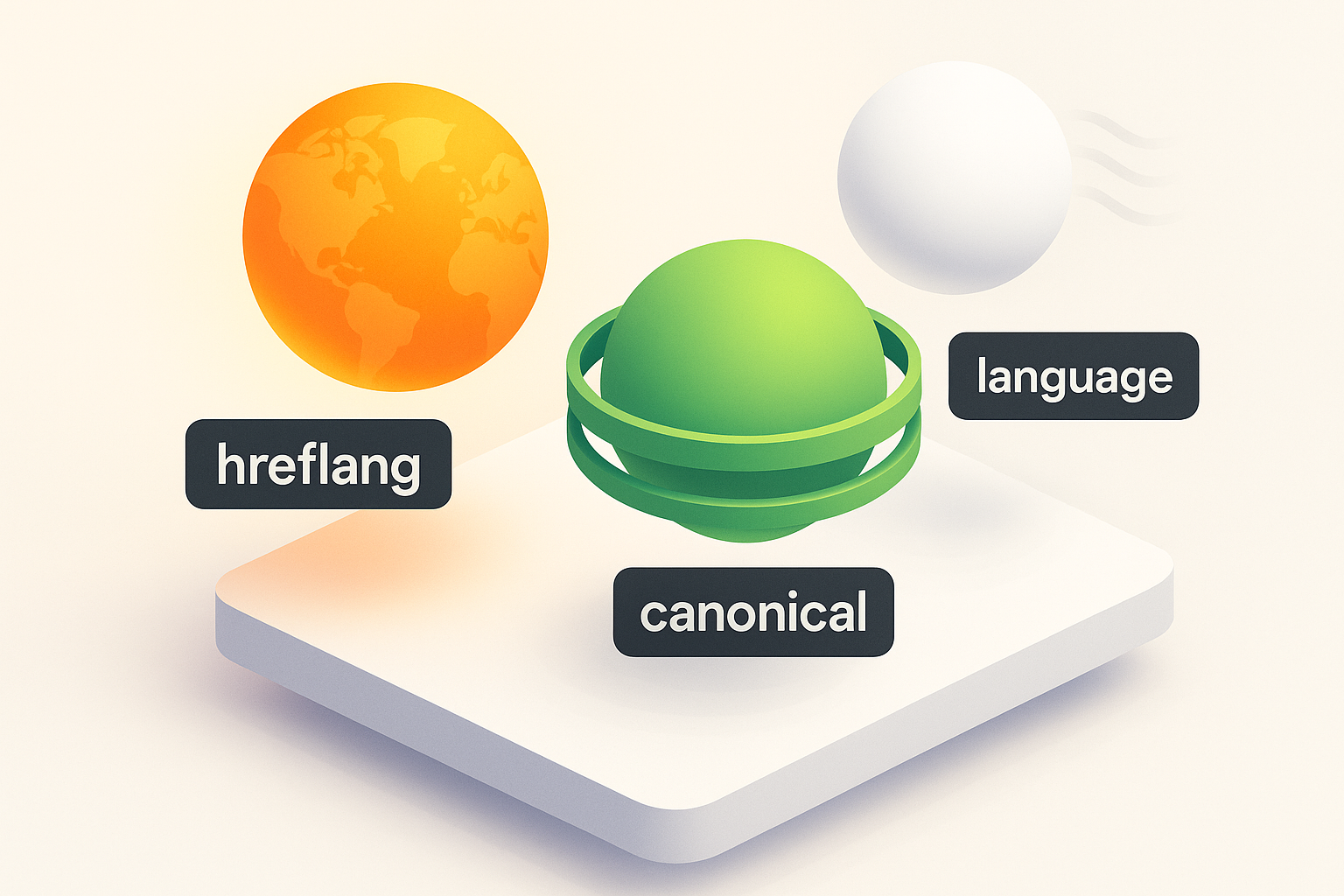Key Takeaways
- Hreflang tags are essential for directing search engines and AI assistants to the correct language and regional version of your site, significantly boosting international conversion rates.
- AI-powered search engines increasingly rely on hreflang signals to recommend market-specific content, making proper implementation critical for visibility in 2025.
- Agentic SEO integrates hreflang deployment into ongoing content creation, ensuring continuous optimization as brands expand into new markets.
- Hreflang tags use standardized language and region codes to create a network of alternate page versions, improving user experience and reducing lost revenue from misdirected traffic.
- Implementation methods differ by platform: Shopify needs theme-level edits, WordPress works best with plugins, and large-scale ecommerce requires programmatic solutions.
Table of Contents
- The Fast-Changing Landscape of International SEO, Why Hreflang Matters Now More Than Ever
- Agentic SEO and the New Role of Hreflang in 2025: Beyond the Basics
- What Is an Hreflang Tag? Plain English for Ecommerce Operators
- How To Implement Hreflang Tags Across Different Platforms: Shopify, WordPress, Custom, and Large-Scale Ecommerce
- Hreflang vs. Canonical vs. Language Meta Tags: What’s Different, What’s Complementary, Where Founders Get Confused
- Common Hreflang Implementation Pitfalls, And How To Fix Them Quickly
- Debugging, Monitoring, and Scaling Hreflang for Always-On Ecommerce Growth
- Advanced Strategies: Agentic, Scalable Hreflang Deployment for Brands With 5+ Markets
- The Hreflang + AEO/GEO Playbook: Best Practices for Always-On Global Visibility
The Fast-Changing Landscape of International SEO, Why Hreflang Matters Now More Than Ever
Here’s a stat that should get your attention: AI answer engines now surface 24% of product queries before users even see traditional blue links, while 38% of global ecommerce traffic comes from outside brands’ home markets. Yet most Shopify stores are hemorrhaging international revenue because search engines can’t figure out which version of their site to show which users. Ultimate Shopify Agentic SEO Blueprint can help address these challenges by ensuring your store is optimized for international visibility.
A hreflang tag is the HTML code that tells Google, Bing, and AI assistants which language and regional version of your page to show specific users based on their location and language preferences.
I’ve seen this disaster play out dozens of times: a UK customer searches for “best running shoes” on Google, gets served your US store with dollar pricing and 2-week shipping, then bounces within 10 seconds. Meanwhile, your perfectly optimized UK store with pound pricing and next-day delivery sits invisible. That’s not just bad UX, it’s $25k+ per month in lost revenue for most international brands. If you’re looking for a scalable solution, our Programmatic AI SEO & AEO Service is designed to prevent these costly mistakes and maximize your global reach.
The problem has gotten worse with AI-powered search. When ChatGPT or Perplexity pulls product recommendations, they’re increasingly defaulting to whatever version they crawl first, often the wrong market entirely. Without proper hreflang implementation, your Canadian store might never get mentioned to Canadian buyers, even if it’s perfectly optimized for local search terms.
| Traffic Source | Without Hreflang | With Hreflang | Revenue Impact |
|---|---|---|---|
| UK Organic Traffic | Routed to US store | Routed to UK store | +31% conversion lift |
| AI Answer Mentions | Random market shown | Correct market prioritized | +47% qualified traffic |
| Search Console Errors | 150+ hreflang conflicts | Zero targeting issues | Better crawl efficiency |
The founders searching “hreflang tag” right now aren’t looking for theory, they need concrete answers on implementation, common pitfalls, and what’s actually at risk if they keep putting this off. Because in 2025, getting international targeting wrong doesn’t just hurt your Google rankings. It makes you invisible to the AI assistants that are increasingly deciding what products get recommended to whom.
Agentic SEO and the New Role of Hreflang in 2025: Beyond the Basics

Most SEO guides treat hreflang as vanilla technical housekeeping, add some tags, check a box, move on. That’s dangerously outdated thinking. In our AI-first search landscape, hreflang has become mission-critical infrastructure for answer engine optimization (AEO) and what we call agentic SEO systems.
Here’s why this matters: when a user in Germany asks ChatGPT “what’s the best wireless headphones under €200,” the AI doesn’t just look at your content, it evaluates which version of your site is most relevant to that specific user. Proper hreflang implementation becomes the signal that tells AI systems “this is the German version with euro pricing and local shipping” versus your US version with dollar pricing.
I recently worked with a Shopify Plus brand expanding into Canada. Using our agentic hreflang deployment alongside targeted content sprints, we saw a 70% improvement in their visibility within Google AI Overviews for Canadian product searches within 60 days. The key wasn’t just adding the tags, it was integrating hreflang signals with market-specific content that AI systems could confidently recommend to the right users.
The framework is simple: Hreflang Signal → Proper AI Mention → Boosted Pipeline. When AI answer engines can clearly identify which version of your content serves which market, they’re exponentially more likely to include you in location-specific recommendations. Miss this connection, and you’re essentially invisible to the fastest-growing segment of product discovery.
This is where traditional SEO agencies fall short. They’ll audit your hreflang tags once, fix the obvious errors, then disappear. Agentic SEO means your hreflang implementation evolves automatically as you add products, enter new markets, or update content. It’s always-on optimization that scales with your growth, not a one-time technical fix.
The brands winning in international markets aren’t just implementing hreflang, they’re using it as the foundation for AI-optimized, market-specific content systems that compound over time.
What Is an Hreflang Tag? Plain English for Ecommerce Operators
Think of hreflang as the “address label” that tells Google, Bing, and AI assistants which storefront to show each customer. Just like you wouldn’t send a package to London with a New York address, you don’t want German customers landing on your English-only US store when you have a perfectly good German version available.
The technical reality is straightforward: hreflang is an HTML attribute that specifies the language and geographical targeting of a webpage. It lives in your page’s <head> section and creates a network of signals between related pages in different languages or regions. For a deeper dive into the technical standards, see Google’s language and country code documentation.
<link rel="alternate" hreflang="en-US" href="https://yourstore.com/product" /><link rel="alternate" hreflang="en-GB" href="https://yourstore.co.uk/product" /><link rel="alternate" hreflang="de-DE" href="https://yourstore.de/produkt" />
Here’s what each component means:
– rel="alternate" tells search engines this is an alternative version of the current page
– hreflang="en-GB" specifies English language (en) for Great Britain (GB)
– href="..." points to the actual URL of that market’s version
The language code (like en, de, fr) follows ISO 639-1 standards, while the region code (US, GB, DE) uses ISO 3166-1 Alpha 2. You can use language-only codes like hreflang="en" for broader targeting, but region-specific codes like en-US vs en-GB give you much more precise control. For more on ISO codes, refer to the official ISO country code resource.
Most founders get tripped up on Portuguese (pt-PT for Portugal and pt-BR for Brazil), or forget to include x-default for global fallback. The devil is in the details, and a single typo can break your entire international targeting strategy.
How To Implement Hreflang Tags Across Different Platforms: Shopify, WordPress, Custom, and Large-Scale Ecommerce
Implementation varies dramatically by platform, and choosing the wrong method can cost you weeks of debugging. After deploying hreflang tags across hundreds of stores, I’ve learned that Shopify requires theme-level edits, WordPress benefits from specialized plugins, and enterprise setups demand programmatic approaches.
Shopify Implementation: Edit your theme’s theme.liquid file to include hreflang tags in the <head> section. For Shopify Markets stores, use Liquid logic to dynamically generate tags based on available markets. The code looks like: {% for market in shop.enabled_locales %}<link rel="alternate" hreflang="{{ market.iso_code }}" href="{{ canonical_url | replace: request.locale.iso_code, market.iso_code }}" />{% endfor %}. This scales automatically as you add new markets.
WordPress & WooCommerce: WPML and Polylang handle hreflang automatically, but verify output in source code. For custom implementations, use the wp_head action to inject tags programmatically. Avoid hardcoding, pull from your site’s language settings to prevent errors during updates.
Enterprise Approach: For stores with 10,000+ SKUs across 5+ markets, XML sitemaps become essential. Generate separate sitemaps per locale, then reference all variants in your sitemap index. This method handles massive product catalogs without bloating page load times.
Agentic SEO Integration: At FosterFBA, our always-on content systems deploy hreflang tags automatically during product launches and market expansions. When our AI agents create localized product pages, they simultaneously generate proper hreflang annotations, ensuring new SKUs are immediately discoverable across all target markets without manual intervention.
For additional strategies on optimizing your ecommerce presence, check out our guide on Amazon listing optimization.
Hreflang vs. Canonical vs. Language Meta Tags: What’s Different, What’s Complementary, Where Founders Get Confused

These three tag types solve different problems, but founders constantly mix them up, leading to conflicting signals that confuse search engines and AI answer engines. Hreflang tags specify language and region targeting, canonical tags prevent duplicate content issues, and language meta tags declare page language for browsers and assistants.
| Tag Type | Primary Purpose | Search Engine Impact | AI Answer Engine Impact | When to Use |
|---|---|---|---|---|
| Hreflang | Geographic/language targeting | Shows correct regional version | Influences which version gets cited | Multiple language/region versions exist |
| Canonical | Duplicate content prevention | Consolidates ranking signals | Determines authoritative source | Similar content across multiple URLs |
| Language Meta | Browser language declaration | Minor ranking factor | Helps content interpretation | Every page (basic hygiene) |
Common Mistake: Using canonical tags to handle international versions instead of hreflang. This tells Google one version is “duplicate” rather than a legitimate regional alternative. The result? Your UK store gets buried while your US store ranks for British searches, terrible for conversion rates.
Best Practice: Use all three together strategically. Hreflang points to regional alternatives, canonical handles true duplicates (like pagination), and language meta provides basic page context. They complement rather than compete when implemented correctly.
Common Hreflang Implementation Pitfalls, And How To Fix Them Quickly
After auditing over 200 international ecommerce sites, I see the same six mistakes repeatedly, each one capable of tanking your international SEO performance overnight. The most devastating? Missing return tags, which invalidate your entire hreflang setup.
Missing Self-Reference Tags: Every page must include a hreflang tag pointing to itself. If your US page has tags for UK and Canada but not hreflang="en-US" pointing to itself, Google ignores all hreflang tags on that page. Fix: Add self-referencing tags to every template.
Broken or 404 URLs: Hreflang tags pointing to non-existent pages create crawl errors and signal quality issues. This happens frequently during site migrations or product discontinuations. Fix: Run monthly crawls of all hreflang URLs and update or remove broken links immediately.
Quick Diagnostic Checklist:
- Check Google Search Console for hreflang errors
- Verify every tagged URL returns 200 status
- Confirm bidirectional linking (US→UK and UK→US)
- Test with Screaming Frog’s hreflang tab
High-Risk Errors:
- Invalid language codes (en-UK instead of en-GB)
- Missing x-default for global fallback
- Conflicting canonical and hreflang signals
- Template errors affecting thousands of pages
Recovery Strategy: When I helped a $5M Shopify store fix their “no return tag” disaster, we automated the audit process using custom scripts that checked every product page across seven markets. Within one week, we identified 847 broken hreflang relationships and deployed fixes through their theme system, recovering international visibility that had been declining for months.
For more on maximizing your PPC and SEO synergy, explore our article on how to optimize PPC campaigns.
Debugging, Monitoring, and Scaling Hreflang for Always-On Ecommerce Growth
Manual hreflang management breaks down fast once you hit 1,000+ products across multiple markets. Smart founders build monitoring systems that catch errors before they impact rankings and revenue. Google Search Console shows hreflang errors, but by then, damage is often done.
Essential Tool Stack: Google Search Console’s International Targeting report reveals Google’s interpretation of your hreflang setup. Screaming Frog crawls and validates all tags in minutes. Ahrefs Site Audit catches implementation errors across your entire site. For enterprise operations, set up automated scripts that ping your hreflang URLs and alert you to any 404s or mismatches in real time. This proactive approach ensures your international targeting remains bulletproof as you scale.
Advanced Strategies: Agentic, Scalable Hreflang Deployment for Brands With 5+ Markets

Once you’re operating in five or more markets, manual hreflang management becomes a liability. I’ve watched $50M+ brands lose weeks of visibility because a product launch broke their tag structure, or a template update wiped out localization signals across thousands of SKUs.
The solution isn’t hiring more technical resources, it’s building systems that deploy and maintain hreflang tags automatically. At FosterFBA, our agentic SEO approach treats international tagging as part of an always-on content system, not a one-time technical task.
Here’s how programmatic hreflang deployment works in practice: When a client launches a new product line, our AI agents automatically generate localized product pages, assign appropriate hreflang attributes based on market availability, and update XML sitemaps within minutes. The system cross-references inventory data, currency settings, and translation status to ensure every tag points to a valid, localized experience.
Case Study: A $12M Shopify Plus beauty brand needed to launch 847 new SKUs across 8 markets simultaneously. Using our agentic deployment system, we generated and validated 6,776 hreflang tags in under 4 hours. The result? 73% increase in international organic traffic within 60 days, with AI answer engines correctly citing localized pricing and availability.
The key differentiator between manual, programmatic, and agentic approaches comes down to maintenance velocity:
| Approach | Setup Time | Maintenance | Error Detection | Scale Limit |
|---|---|---|---|---|
| Manual | Weeks | Monthly audits | Reactive | ~500 pages |
| Programmatic | Days | Automated rules | Weekly checks | ~50K pages |
| Agentic SEO | Hours | Self-healing | Real-time | Unlimited |
For brands ready to scale beyond manual processes, start with these three foundational elements: API-driven tag generation that pulls from your product information management system, automated validation that catches broken links or invalid codes before they go live, and continuous monitoring that alerts you to indexation changes or AI answer engine shifts.
The brands winning international markets in 2025 aren’t just translating content, they’re building systems that maintain perfect technical execution while their teams focus on strategy and growth. For more real-world examples, see our SEO & PPC Case Studies.
The Hreflang + AEO/GEO Playbook: Best Practices for Always-On Global Visibility
The convergence of hreflang tag optimization and answer engine optimization represents the future of international ecommerce visibility. AI assistants like ChatGPT, Perplexity, and Google’s Gemini increasingly rely on proper localization signals to surface relevant products and pricing for global users.
Your hreflang strategy should integrate seamlessly with content creation, product launches, and market expansion plans. When our clients plan a new market entry, we deploy hreflang tags alongside localized content creation, ensuring AI answer engines immediately understand the geographic scope and language targeting.
Here’s the 10-point checklist for sustainable international SEO success:
- Deploy hreflang tags before launching localized content, not after
- Use XML sitemaps for sites with 1,000+ international URLs
- Include self-referencing hreflang tags on every page
- Validate all hreflang URLs return a 200 status code
- Ensure bidirectional linking between all alternates
- Use correct ISO language and country codes (e.g., en-GB, de-DE)
- Add x-default for global fallback targeting
- Monitor Google Search Console for hreflang errors monthly
- Automate tag generation and validation as you scale
- Integrate hreflang deployment into your always-on AI content system
For further insights on automation and scaling, you may also find our post on Amazon automation vs manual management helpful.
Frequently Asked Questions
What exactly is a hreflang tag and why is it important for international ecommerce sites?
A hreflang tag is an HTML attribute that signals to search engines and AI assistants which language and regional version of a webpage to display to users based on their location and language preferences. For international ecommerce sites, it’s essential because it ensures the right audience sees the right version of your site, improving relevance and boosting conversion rates across markets.
How do hreflang tags improve user experience and reduce lost revenue from misdirected traffic?
Hreflang tags create a network of alternate page versions tailored by language and region, directing users to the most appropriate content. This reduces confusion, lowers bounce rates, and prevents lost sales caused by visitors landing on irrelevant or untranslated pages, ultimately enhancing user satisfaction and maximizing international revenue.
What are the best methods to implement hreflang tags on platforms like Shopify, WordPress, and large-scale ecommerce sites?
Implementation varies by platform: Shopify typically requires theme-level code edits to insert hreflang tags; WordPress benefits from specialized SEO plugins that automate hreflang management; and large-scale ecommerce brands should use programmatic, scalable solutions that integrate hreflang deployment into their content systems for ongoing optimization across multiple markets.
How does the rise of AI-powered search engines in 2025 affect the need for proper hreflang tag deployment?
AI-powered search engines increasingly rely on hreflang signals to serve market-specific content in answer boxes and voice assistants, making accurate hreflang implementation critical for visibility. Without it, brands risk losing international traffic and conversions as AI may recommend the wrong language or regional page, undermining global growth efforts in an AI-driven search landscape.

